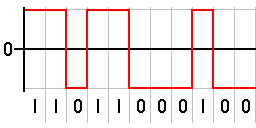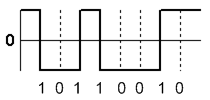
Non-return-to-zero
Encyclopedia

Telecommunication
Telecommunication is the transmission of information over significant distances to communicate. In earlier times, telecommunications involved the use of visual signals, such as beacons, smoke signals, semaphore telegraphs, signal flags, and optical heliographs, or audio messages via coded...
, a non-return-to-zero (NRZ) line code
Line code
In telecommunication, a line code is a code chosen for use within a communications system for baseband transmission purposes...
is a binary code in which 1's are represented by one significant condition (usually a positive voltage) and 0's are represented by some other significant condition (usually a negative voltage), with no other neutral or rest condition. The pulses have more energy than a RZ
Return-to-zero
For the Delp/Goudreau band, see RTZReturn-to-zero describes a line code used in telecommunications signals in which the signal drops to zero between each pulse. This takes place even if a number of consecutive 0's or 1's occur in the signal. The signal is self-clocking...
code. Unlike RZ, NRZ does not have a rest state.
NRZ is not inherently a self-synchronizing code
Self-clocking signal
In telecommunications and electronics, a self-clocking signal is one that can be decoded without the need for a separate clock signal or other source of synchronization...
, so some additional synchronization technique (for example a run length limited
Run Length Limited
Run length limited or RLL coding is a line coding technique that is used to send arbitrary data over a communications channel with bandwidth limits. This is used in both telecommunication and storage systems which move a medium past a fixed head. Specifically, RLL bounds the length of stretches ...
constraint, or a parallel synchronization signal) must be used to avoid bit slip
Bit slip
In digital transmission, bit slip is the loss of a bit or bits, caused by clock drift – variations in the respective clock rates of the transmitting and receiving devices....
.
For a given data signaling rate
Data signaling rate
In telecommunication, data signaling rate , also known as gross bit rate, is the aggregate rate at which data pass a point in the transmission path of a data transmission system.Notes:#The DSR is usually expressed in bits per second....
, i.e., bit rate
Bit rate
In telecommunications and computing, bit rate is the number of bits that are conveyed or processed per unit of time....
, the NRZ code requires only half the bandwidth required by the Manchester code
Manchester code
In telecommunication and data storage, Manchester code is a line code in which the encoding of each data bit has at least one transition and occupies the same time...
.
When used to represent data in an asynchronous communication
Asynchronous communication
In telecommunications, asynchronous communication is transmission of data without the use of an external clock signal, where data can be transmitted intermittently rather than in a steady stream. Any timing required to recover data from the communication symbols is encoded within the symbols...
scheme, the absence of a neutral state requires other mechanisms for bit synchronization when a separate clock signal is not available.
NRZ-Level itself is not a synchronous system but rather an encoding that can be used in either a synchronous or asynchronous transmission environment, that is, with or without an explicit clock signal involved. Because of this, it is not strictly necessary to discuss how the NRZ-Level encoding acts "on a clock edge" or "during a clock cycle" since all transitions happen in the given amount of time representing the actual or implied integral clock cycle. The real question is that of sampling--the high or low state will be received correctly provided the transmission line has stabilized for that bit when the physical line level is sampled at the receiving end.
However, it is helpful to see NRZ transitions as happening on the trailing (falling) clock edge in order to compare NRZ-Level to other encoding methods, such as the mentioned Manchester code, which requires clock edge information (is the XOR of the clock and NRZ, actually) and to see the difference between NRZ-Mark and NRZ-Inverted.
Unipolar Non-Return-to-Zero Level
"One" is represented by one physical level (such as a DC bias on the transmission line)."Zero" is represented by another level (usually a negative voltage).

In clock language, "one" transitions or remains high on the trailing clock edge of the previous bit and "zero" transitions or remains low on the trailing clock edge of the previous bit, or just the opposite. This allows for long series without change, which makes synchronization difficult. One solution is to not send bytes without transitions. Disadvantages of an on-off keying are the waste of power due to the transmitted DC level and the power spectrum of the transmitted signal does not approach zero at zero frequency. See RLL
Run Length Limited
Run length limited or RLL coding is a line coding technique that is used to send arbitrary data over a communications channel with bandwidth limits. This is used in both telecommunication and storage systems which move a medium past a fixed head. Specifically, RLL bounds the length of stretches ...
Bipolar Non-Return-to-Zero Level
"One" is represented by one physical level (usually a positive voltage)."Zero" is represented by another level (usually a negative voltage).
In clock language, in bipolar NRZ-Level the voltage "swings" from positive to negative on the trailing edge of the previous bit clock cycle.
An example of this is RS-232
RS-232
In telecommunications, RS-232 is the traditional name for a series of standards for serial binary single-ended data and control signals connecting between a DTE and a DCE . It is commonly used in computer serial ports...
, where "one" is -12V to -5V and "zero" is +5 to +12V.
Non-Return-to-Zero Space

"Zero" is represented by a change in physical level.
In clock language, the level transitions on the trailing clock edge of the previous bit to represent a "zero."
This "change-on-zero" is used by High-Level Data Link Control
High-Level Data Link Control
High-Level Data Link Control is a bit-oriented synchronous data link layer protocol developed by the International Organization for Standardization...
and USB. They both avoid long periods of no transitions (even when the data contains long sequences of 1 bits) by using zero-bit insertion. HDLC transmitters insert a 0 bit after five contiguous 1 bits (except when transmitting the frame delimiter '01111110'). USB transmitters insert a 0 bit after six consecutive 1 bits. The receiver at the far end uses every transition — both from 0 bits in the data and these extra non-data 0 bits — to maintain clock synchronization. The receiver otherwise ignores these non-data 0 bits.
Non-Return-to-Zero Inverted (NRZI)


Map (mathematics)
In most of mathematics and in some related technical fields, the term mapping, usually shortened to map, is either a synonym for function, or denotes a particular kind of function which is important in that branch, or denotes something conceptually similar to a function.In graph theory, a map is a...
a binary
Binary numeral system
The binary numeral system, or base-2 number system, represents numeric values using two symbols, 0 and 1. More specifically, the usual base-2 system is a positional notation with a radix of 2...
signal to a physical signal for transmission
Transmission (telecommunications)
Transmission, in telecommunications, is the process of sending, propagating and receiving an analogue or digital information signal over a physical point-to-point or point-to-multipoint transmission medium, either wired, optical fiber or wireless...
over some transmission media. The two level NRZI signal has a transition at a clock boundary if the bit
Bit
A bit is the basic unit of information in computing and telecommunications; it is the amount of information stored by a digital device or other physical system that exists in one of two possible distinct states...
being transmitted is a logical 1, and does not have a transition if the bit being transmitted is a logical 0.
"One" is represented by a transition of the physical level.
"Zero" has no transition.
Also, NRZI might take the opposite convention, as in Universal Serial Bus
Universal Serial Bus
USB is an industry standard developed in the mid-1990s that defines the cables, connectors and protocols used in a bus for connection, communication and power supply between computers and electronic devices....
(USB) signalling, when in Mode 1 (transition when signalling zero and steady level when signalling one).
The transition occurs on the leading edge of the clock for the given bit. This distinguishes NRZI from NRZ-Mark.
However, even NRZI can have long series of zeros (or ones if transitioning on "zero"), so clock recovery
Clock recovery
Some digital data streams, especially high-speed serial data streams are sent without an accompanying clock signal. The receiver generates a clock from an approximate frequency reference, and then phase-aligns to the transitions in the data stream with a phase-locked loop...
can be difficult unless some form of run length limited
Run Length Limited
Run length limited or RLL coding is a line coding technique that is used to send arbitrary data over a communications channel with bandwidth limits. This is used in both telecommunication and storage systems which move a medium past a fixed head. Specifically, RLL bounds the length of stretches ...
(RLL) coding is used on top. Magnetic disk and tape storage devices generally use fixed-rate RLL codes, while USB uses bit stuffing
Bit stuffing
In data transmission and telecommunication, bit stuffing is the insertion of noninformation bits into data...
, which is efficient, but results in a variable data rate: it takes slightly longer to send a long string of 1 bits over USB than it does to send a long string of 0 bits. (USB inserts an additional 0 bit after 6 consecutive 1 bits.)
See also
- Bipolar encodingBipolar encodingIn telecommunication, bipolar encoding is a type of line code . A duobinary signal is such an encoding.- Advantages :...
- Enhanced Non-Return-to-Zero-Level E-NRZ-LE-NRZ-LIn telecommunication, an enhanced-non-return-to-zero-level line code is a binary code in which 1s are represented by one significant condition and 0s are represented by some other significant condition , with no other neutral or rest condition, similar to Non-return-to-zero; However, the major...
- Return-to-zeroReturn-to-zeroFor the Delp/Goudreau band, see RTZReturn-to-zero describes a line code used in telecommunications signals in which the signal drops to zero between each pulse. This takes place even if a number of consecutive 0's or 1's occur in the signal. The signal is self-clocking...
- Line codeLine codeIn telecommunication, a line code is a code chosen for use within a communications system for baseband transmission purposes...
- Universal asynchronous receiver/transmitterUniversal asynchronous receiver/transmitterA universal asynchronous receiver/transmitter, abbreviated UART , is a type of "asynchronous receiver/transmitter", a piece of computer hardware that translates data between parallel and serial forms. UARTs are commonly used in conjunction with communication standards such as EIA RS-232, RS-422 or...
- Manchester codeManchester codeIn telecommunication and data storage, Manchester code is a line code in which the encoding of each data bit has at least one transition and occupies the same time...

